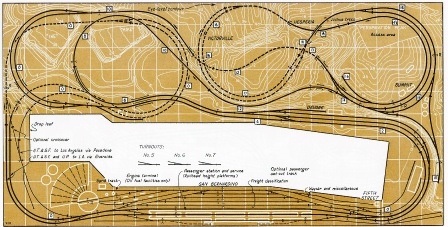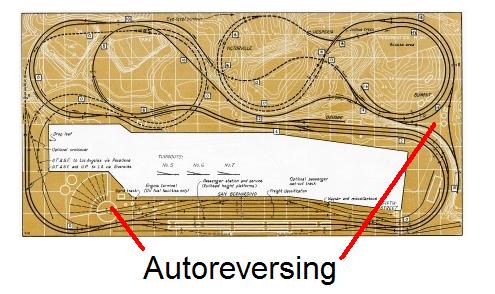

I am putting the finishing touches on my 10 x 20 foot H0 railroad.
It is a copy of the Cajon Pass, Salt Lake & Santa Fe RR by John Armstrong (#86 in the 101 Track Plans by Linn Westcott) [Kalmbach Publishing, ISBN 0-89024-512-6; still in print].
I have decided to go with DCC and my local hobby store recommended Digitrax.
The layout is in my basement, I will be the only operator, the plan has 54 track switches (34 NJ International twin coils and 20 Tortoise turnout motors).
Can you give me an idea as to what equipment I will need to get my layout working?
My locomotives are all steam (Rivarossi) and were purchased about 25-30 years ago.
101 Track Plans for Model Railroaders is one of our favorite books, and quite popular with model railroaders everywhere, so much so that it has stayed in print since 1956.
And, the Cajon Pass, Salt Lake & Santa Fe is another great railroad design from the late, great John Armstrong.
Keep in mind that because Digitrax has LocoNet, you can start with a basic system and then expand as you want.
So, here's what we think you'll need....
Basic Items
- Radio Equipped Super Chief Premium Set
- PS2012 Power Supply
- DB200+ Booster (as needed)
- PM42 Power Managers
- UP5 Universal Panels
- DS64 Quad Stationary Decoders
- UT4R Utility Throttle
- Power Supplies for the PM42's
- Power Supplies for the DS64's
Optional Items - BDL168 LocoNet Occupancy Detector
- SE8C Signal Decoder
Power Considerations
First, one major consideration is how much electrical power you will need to operate your railroad.
For purposes of estimation, here are some guidelines.
Each locomotive is going to draw, at the very least, 5 MA for the decoder.
If it has LED lights, then it will typically draw 15 MA more; conventional light bulbs will draw 50 MA.
A typical H0 locomotive will draw 600 MA when it is in operation.
So, each locomotive can be expected to draw 650 MA in H0.
This number will be higher if you are using a locomotive equipped with sound.
Assuming that there will be up to 5 trains operating at a time, the total locomotive power consumption for your railroad will be 3.25 Amps (650 MA per locomotive x 5 locomotives).
Of course, you will have more locomotives sitting idle in the yards.
Likewise, passenger cars with internal light bulbs will draw 50 MA per car, those with internal LED lighting will draw 15 MA per car.
Once you have an overall idea as to the total power requirements for your railroad, you will subdivide the railroad into power districts, with the Super Chief command station handling one part of the railroad and the booster handling another portion.
Additional boosters are connected to LocoNet and their own power supply.
The boosters take train control information from LocoNet and relay it to the segment which they power.
You may discover that you need even more power than what is described here, so it is important to wire your railroad in such a way that you can disconnect segments of track and connect them to another booster.
It is also important the the railroad be wired in the Direct Home method.
This insures reliable operation of your Digitrax system.
Power Management
Within each district powered by the command station / booster and the additional power districts powered by the DB200+, you will use one or more PM42 power managers.
Each PM42 has four sections which are used to provide short circuit protection.
Although the Super Chief has a circuit breaker, it is best to add the PM42's since they subdivide the railroad in such a way that a short circuit in one location does not cause a short circuit in other areas on the railroad.
Also, the PM42 can be configured for autoreversing, which could be used for both the turntable in the locomotive area and at the turning wye at the top of the Pass.

LocoNet
LocoNet is the data backbone of your railroad, connecting most Digitrax devices together and coordinating train operations.
LocoNet is a peer to peer network, which means that you can easily add or remove devices as your needs change.
As an example, the Super Chief Radio starter set includes a UR91 Radio/IR Receiver Unit which is the radio receiver for the DT400R throttle.
The UR91 is connected to LocoNet, along with a power source, and you control trains wirelessly.
Likewise, you may want to add UP5 Universal Panels at convenient locations; these also provide a direct connection to the LocoNet.
As your railroad's needs grow, you can easily expand because of the flexibility of LocoNet.
Stationary Decoders
Stationary decoders are a class of decoder which are used to control track switches, operate signals and handle other railroad operations.
For your turnouts, you will use the DS64 stationary decoder, which operates the track switches.
The DS64 can handle either solenoid turnout motors such as the NJI machines or slow motion decoders such as the Tortoises.
Each DS64 handles either coil type or slow motion type, so you will need 9 DS64's for the NJI machines and 5 DS64's for the Tortoises.
Note that there is a possible alternative for the Tortoise control, below in the SE8C discussion.
In addition to turnout control, the DS64 can also be used for setting up automated routes and local push button control.
Because it is a LocoNet device, the DS64 also sends coordinating information to other LocoNet devices.
Mobile Decoders
Mobile decoders are the decoders which are primarily used in your locomotives, but there are also mobile decoder applications in freight and passenger cars.
The decoders are grouped by general size, with the DZ-series being the the smallest and the DG-series being the largest.
Within each group, there are different amperage ratings and features.
The basic DH123 Economy Series decoder retails for $22.99 and only controls two functions, usually the headlights.
The more advanced DH163 series decoder retails for $29.99 and controls both headlights and an additional four functions.
Both are rated at 1.5 Amperes.
Your major concern with the choice of decoders involves the stall current of the individual locomotive.
The older Rivarossi locomotives you are going to use often have three pole motors and were designed in a time when DCC was an undeveloped concept.
So, it is possible that some of your locomotives may require a new motor, depending upon circumstances.
Modern locomotives often come with provisions for quick installation of decoders, while the older units require a bit more work.
It is possible to do this work yourself, but you may want to rely upon the services of a skilled installer, especially in light of how many engines you will convert.
At first, the sheer numbers of locomotives to be converted can be daunting, but many operators start by converting their favorite locomotives and then gradually expand out into their fleet.
In some cases, it is not possible to convert a locomotive to DCC, but this event is a rarity.
Throttles
Throttles allow you to connect to LocoNet for train operations.
While the Super Chief set comes with a DT400 throttle, we have added a UT4 Utility Throttle to your list.
The DT400 is a handful, in more ways than one; the UT4 is a simpler device, perfect for just running trains.
The DT400 is necessary for programming the PM42 and for programming your system in general.
And, since the DT400 has two throttle controls, it makes forming locomotive consists very easy.
At the same time, the UT4 is perfect in its simplicity, and very handy whenever you have visitors who get easily intimidated by complicated looking devices.
Power Supplies
We have recommended a PS2012 power supply for your general operations; the power output from this 20 Amp unit can be subdivided.
It is important that each PM42 has its own power source; this would be the PS14.
Likewise, the DS64's need their own power sources, and one PS14 can power two or three DS64's.
In addition to the basic items described above, you can also add train detection and signaling to your railroad.
This adds both a layer of complexity and also greater realism in your railroad's operation.
At the core of signal operation is the detection of trains, the operation of the signals and the signal logic.
Train Detection
The location of trains is provided by the BDL168, which detects 16 segments of track.
The BDL168 then sends the detection information to LocoNet.
In taking a quick look at the railroad, it would appear that two BDL168's would be sufficient.
You would want train detection on the main lines and in the passenger station area, but probably not in the freight yard and engine terminal areas.
Signal Operation
The railroad signals are operated by the SE8C.
The SE8C can operate color light signals which use LED's, or semaphores that use slow motion switch machines (such as the Tortoise).
As mentioned earlier, it is possible to power some of your Tortoise switch machines with the SE8C, using other portions of the SE8C to drive to color light signals.
Signal Logic
A computer program is used to coordinate the detection information with the signal displays.
In many cases, the computer in question is one that has been retired from other uses, and there are several train control programs on the market, notably JMRI and Railroad & Co.
Order of Connection
There is an order in which Digitrax devices are connected; please see the related article.
We are glad that you are considering Digitrax, and wish you great success with this very interesting railroad.